It’s no secret that people with borderline personality disorder (BPD) face some of the harshest stigma in the mental health community. From clinicians who flat out refuse to treat patients with BPD, to articles online generalizing people with BPD as “monsters” and “life-ruiners,” it’s no wonder folks who live with this condition often feel isolated and ashamed of their diagnosis.
Because there is so much misinformation about BPD out there, we wanted to put together a guide featuring frequently asked questions about BPD with information (and support) you can trust. We spoke with psychologist Dr. April Foreman, who specializes in borderline personality disorder, to answer some of our burning BPD questions. If you think you may have BPD, we hope this article can provide you some insight and jumpstart a discussion with your doctor or mental health professional to get you the specific help you need.
Here’s a breakdown of the questions we will cover in this piece. To navigate the article easily, we’ve included bookmarks of the questions below, so feel free to click on the topic you find most interesting, and the link will take you to that portion of the article.
- What is a personality disorder?
- What is borderline personality disorder and how is it diagnosed?
- Can you “recover” from borderline personality disorder?
- What “causes” borderline personality disorder?
- Is someone with borderline personality disorder “doomed” to have bad relationships?
- Why are more females than males diagnosed with borderline personality disorder?
- Why are clinicians often hesitant to diagnose people with borderline personality disorder?
- How often is borderline personality disorder misdiagnosed? How can I get an accurate diagnosis?
- I think I have borderline personality disorder. What now?
First things first, what is a personality disorder?

When people hear the phrase “personality disorder,” it can be easy to think it means a person is inherently flawed or has a “bad” personality.
“The terminology is really unfortunate, and it causes people a lot of pain,” Dr. Foreman told The Mighty. She shared that a less painful term for a personality disorder — though much more clinical — is called an ego-syntonic disorder.
But what is that exactly?
To define ego-syntonic, Dr. Foreman explained its opposite — ego-dystonic disorders.
With ego-dystonic disorders, which are the majority of mental health disorders, you get a mental health condition that feels really different from your identity, who you are as a person and how you function every day. It’s like when you get the flu but the flu isn’t how you normally are.
A good example of an ego-dystonic disorder is depression. When someone gets depressed, a lot of times their behavior and thoughts are out of character for them. Dr. Foreman explained an ego-syntonic disorder differs because it is a mental health disorder that is part of who you are every day. She said borderline personality disorder (BPD) is a good example of an ego-syntonic disorder.
“With borderline personality disorder, your emotions just don’t regulate themselves as easily. It’s like having a really glitchy emotional thermostat, and then a bunch of issues happen as a result.”
If you are struggling with understanding what a “personality disorder” really means, Mighty contributor Ally Voigt summed it up perfectly in her piece, “What TF Is a Personality Disorder?” She wrote,
Personality disorders aren’t as horrific as they first sound. It doesn’t mean you’ve got a shit personality or that you are like a malfunctioning robot. No steam is going to come out of your ears, and you won’t lose a spring or pop rivet. Personality disorders are mental disorders that are basically long-term patterns of behavior which can make it difficult to function on the daily.
What is borderline personality disorder and how is it diagnosed?
Borderline personality disorder (BPD) is a mental illness characterized largely by the inability to regulate emotions, which can cause a person with BPD to have painful and unstable interpersonal relationships. In the Diagnostic and Statistical Manual (DSM), BPD is associated with nine “classic” symptoms, which we’ve summarized briefly below. If you want to know more, we did an in-depth explainer of the nine symptoms (using memes!). You can read it here.
Symptoms of Borderline Personality Disorder
- Making frantic efforts to avoid real or imagined abandonment.
- Having a pattern of unstable relationships often characterized by idealizing or devaluing a person (also known as black and white thinking or “splitting”).
- Struggling with unstable self-image or identity.
- Engaging in risky or impulsive behavior.
- Having frequent suicidal thoughts or engaging in self-harm.
- Experiencing periods of emotional intensity, or frequent/rapid mood swings.
- Having chronic feelings of emptiness.
- Living with intense or uncontrollable anger.
- Dissociating or having an “out of body,” disconnected from yourself-type feeling.
Usually someone must meet at least five of the nine diagnostic criteria in order to receive a diagnosis of BPD. Dr. Foreman said that while the DSM typically uses this “checklist” approach, in practice, clinicians are highly variable in how they diagnose. Dr. Foreman says when she is assessing whether or not a patient has BPD, she’s looking for a number of things.
Number one, I’m looking for really painful mood dysregulation that is sort of all the time. Like if they’re awake, their mood is swinging on them… I’m looking for someone who tells me they have really intense, unstable relationships… I’m looking for someone who reports frequent bouts of temper, and I’m looking for someone who often says they feel suicidal a lot and can’t regulate that. [Someone who] often does really painful things to regulate these intense feelings. They’re using sex or drugs or self-harm, they’re using fast driving or other impulsive behaviors as very understandable attempts to regulate a mood they don’t seem to have the skills to regulate.
Dr. Foreman also elaborated on a common symptom that isn’t recognized often enough in many folks with BPD — dissociative symptoms. She said especially in men with BPD, this symptom comes up during emotionally intense states.
“When they have mood dysregulation, they have periods of really disturbed perception. Like they are foggy, they can’t concentrate,” she explained. “They’ll report these periods where they sort of ‘zone out’ and they don’t track things, or remember things well.” She said people with BPD who report dissociative feelings can also perceive themselves as a different person and struggle with memory and cognition.
There are many symptoms of BPD that come up in other mental health disorders. For example, someone with depression might struggle with self-harm or suicidal thoughts, and someone with bipolar disorder might engage in risky sexual behavior while manic. Exhibiting behaviors commonly associated with BPD doesn’t automatically mean you have BPD. As discussed in the above section, a lot of what separates personality disorders (or egosyntonic disorders) from other kinds of mental health disorders is the fact that they are long-term patterns of behavior. It’s important to talk to your doctor to get an accurate diagnosis.
Dr. Foreman said in diagnosing a patient with BPD, one of the most important indicators she looks for is how their behavior affects their day-to-day life.
It really has to impair your functioning. These people maybe can’t stay in marriages or relationships. These people maybe lose their jobs a lot. These people have family that reject them, so they can’t stay close to their parents or their siblings or their children. They maybe have multiple arrests, substance abuse problems, getting pregnant when they don’t intend to or getting sexually transmitted diseases from impulsive sex… Getting into lots of debt from impulsive spending or gambling or things like that. Those are really common things, and it really messes up their lives.
If any of these symptoms sound familiar to you, you’re not alone. As Foreman said, these behaviors are understandable attempts to regulate a rapid cycling mood you may not feel control over. Though it may feel hopeless at times to struggle with these symptoms, we want you to know there is hope for recovery. Please see the next section to read more about this.
Want to know more about living with the symptoms of BPD? Check out these stories from Mighty contributors:
- How Fear of Abandonment Affects the Other Symptoms of My Borderline Personality Disorder
- What It’s Like to Experience Emotional Dissociation
- What You Need to Know About ‘Borderline Rage‘
- What It Feels Like to Lose Your ‘Favorite Person’ When You Live With BPD
- The 3 Stages of My Borderline Personality Disorder Episodes
Can you “recover” from borderline personality disorder?
When asked if she believed people with borderline personality disorder (BPD) could recover, Dr. Foreman replied, “Absolutely, yes. And with effective treatment, it’s very likely. I have definitely had patients recover — more than a few. And they no longer would meet the criteria.”
While some of her patients no longer meet the DSM criteria for BPD, she elaborated that because many of them also have other co-occurring mental health diagnoses like depression or anxiety, they may not experience complete remission of mental illness symptoms.
“I’ve never had them recover from all mental health diagnoses — remember they have several and remember some of those would be genetic, like anxiety or mood disorders — but those become really managed, and their lives get so much better,” she explained.
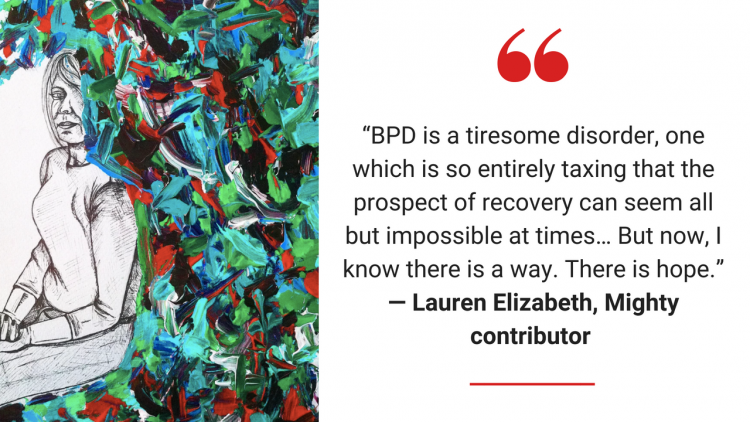
Just because recovery doesn’t always look like an absence of all symptoms, doesn’t mean it’s not worth it. Mighty contributor Lauren Elizabeth wrote about her own recovery process in her piece, “My Journey Through Borderline Personality Disorder to Treatment and Recovery”
This pattern of behavior has consumed most of my 20s, left scars on my body and psyche and cost me opportunities and relationships due to my inability to regulate my emotions. BPD is a tiresome disorder, one which is so entirely taxing that the prospect of recovery can seem all but impossible at times… But now, I know there is a way. There is hope… I am recovering from borderline personality disorder, and you can too. I know the meaning of emptiness. I know what it means to be empty. And I am learning what it means to be filled.
What “causes” borderline personality disorder?
When people think of borderline personality disorder (BPD), they often immediately think of the painful behaviors folks with BPD can engage in. We often assume these behaviors root from willful manipulation, or a desire to cause pain. But more often than not, these painful behaviors are usually just desperate, unskilled attempts by someone with BPD to get emotional needs met that were neglected in an abusive or invalidating upbringing.
In fact, history of adverse childhood experiences is so common in people diagnosed with BPD that in a study about childhood trauma in cases of BPD, it was found that 81 percent of subjects had childhood abuse in their past — 71 percent reported physical abuse, 68 percent sexual abuse and 62 percent had witnessed severe domestic violence.
When a child grows up in an abusive environment that doesn’t meet his or her normal emotional and physical developmental needs, the child may learn to resort to “crafty” and indirect techniques to get what they need to survive. Unfortunately, for many people who have BPD, learned behaviors from childhood can persist and create problems in adulthood even after they’ve left an abusive and invalidating environment.
Dr. Foreman explained why folks with BPD can act often in painful ways to those around them.
Your brain is screaming to have its needs met. It’s screaming to be understood, it’s screaming to be validated, so you start doing some pretty whacky shit in order to get the environment to respond to your brain.
If you’ve experienced childhood trauma that led to your diagnosis of BPD, we want you to know there is hope and you can learn to effectively manage the impulse to “act out” in an attempt to get your needs met. Head here to learn some practical tips for getting your needs met in a direct and skillful way.
It’s important to note that not all people with BPD develop the condition because of childhood abuse. Foreman said some folks just “have really difficult internal emotional experiences that don’t match the environment… [maybe] you have extreme anxiety, extreme depression, extreme mood variability and your environment doesn’t tell you how to manage it.”
Mighty contributor Kellyann Navarre posted a “Thought” about this topic on The Mighty. She shared that when someone finds out she has BPD, they automatically assume past trauma made her “damaged.” She wrote,
People often ask me for a “reason.” Why do I have borderline personality disorder? Why do I have depression? They expect me to go into some dark story and act confused or offended when I can’t… Not that trauma doesn’t play a major role for some people, and not to downplay it, but trauma did not contribute to my BPD and doesn’t play a role by itself.
You can read her full post below. If you want to respond to Kellyann, you can do so by heading here. 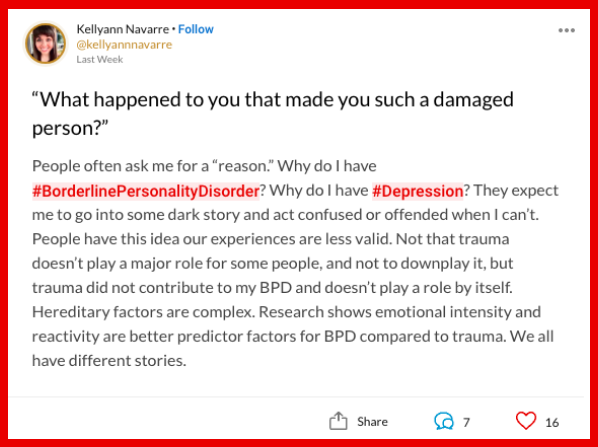
Is someone with borderline personality disorder “doomed” to have bad relationships?
Dr. Foreman said that in diagnosing a patient with borderline personality disorder (BPD), she’s typically looking for a long history of rotating, chaotic and unstable relationships. She said that when someone with BPD is unable to regulate their coping and acts out in painful ways, it’s difficult for people to remain in relationships with them.
But does this mean that someone with BPD is “doomed” to have painful relationships forever? Foreman says no.
If you have borderline personality disorder, by definition, you are having very painful relationships… What I can tell you though is that people with borderline personality disorder can recover and can have good, beautiful, stable relationships. I’ve seen it over and over. [But] you cannot have better relationships until you change something, and you will have to do very hard work to change that.
But what does “hard work” really mean in BPD recovery? It can mean making lifestyle changes, possibly taking medication, but probably most important is going to therapy, doing the “emotional work” of processing through trauma and learning tangible skills to cope.
Foreman, along with virtually every mental health professional who works with people with BPD, believes dialectical behavior therapy (DBT) is the gold standard treatment for BPD recovery. DBT not only teaches people how to have better relationships with their loved ones, but also teaches them how to end toxic relationships.
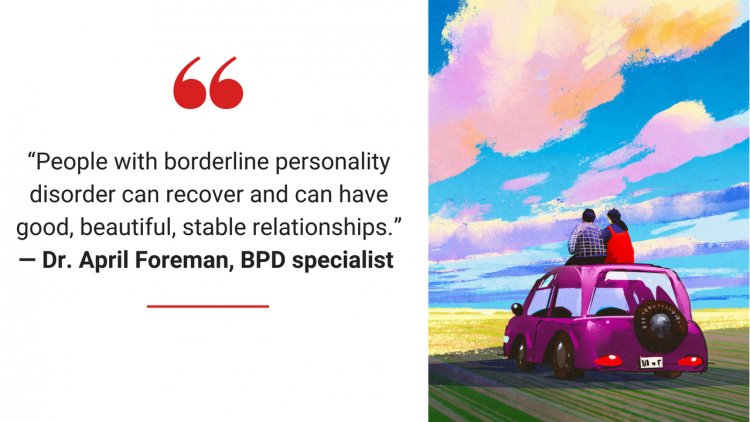
Foreman says that DBT is useful not just for people with BPD, but for everyone looking to improve communication in their relationships. She said she even uses DBT skills in her own relationships with her husband and kids.
To folks who are experiencing relationship difficulties because of a struggle with BPD, you’re not alone and you’re not “past help.” Foreman has a word of encouragement for you: “Please, please please get therapy that works. You deserve a better relationship and by the way, so do the people who love you,” she said.
Why are more females than males diagnosed with borderline personality disorder?
Historically, research has shown that more women than men are diagnosed with borderline personality disorder (BPD), but recent research determined that there are no differences in prevalence of BPD by gender. So although women are diagnosed more often with BPD than men are, the reality is females don’t actually have BPD at a higher rate than men do.
Why then, are females continually diagnosed at a higher rate than men?
“I think there are a couple of reasons,” Dr. Foreman said. “Number one, women are more likely to be victims of oppression and invalidation than men, starting in adolescence and going all throughout life.”
The statistics back up her claim. Of juvenile victims of sexual assault, 82 percent are female, and 90 percent of adult rape victims are female. In terms of intimate partner violence, one in four women (in contrast with one in seven men) have been victims of severe physical violence in their lifetime. Though domestic violence and sexual assault are not the only ways women experience injustice, the numbers speak to the reality that women experience some forms of oppression and invalidation more often than men do.
In addition to the fact that women are victims of oppression more often than men are, Dr. Foreman added, “We have gendered ways that we see and interpret behavior, that’s why men are getting diagnosed less often.”
In a study on gender patterns in borderline personality disorder, researchers found that males and females typically exhibit BPD traits differently, which can affect the diagnosis and treatment they receive. In addition to the fact that women in general feel more comfortable seeking help for their mental health, the researchers found that BPD behavior women exhibit more often than men (like self-harm for example) are also more likely to land them in mental health settings more often than men. Men with BPD, who may be more prone to substance abuse problems and explosive anger outbursts, may instead go to jail or be treated for substance abuse problems alone, rather than BPD.
Dr. Foreman, who works with a (primarily male) veteran population says that often men with BPD are misdiagnosed with other personality disorders because we think of certain behaviors as “classically male.”
“There is some bias in diagnosing. We call men ‘narcissists’ or we call men ‘antisocial…’ But they often do have BPD,” she said.
Want to read more about the experience of men who have BPD? Check out these stories from men with BPD in our Mighty community.
- How I’m Learning to Navigate My BPD Diagnosis as a Male
- Why I’m Not a Monster: Deconstructing Male Borderline Personality Disorder
- When You Don’t Fit the ‘Classic’ Definition of Borderline Personality Disorder
Why are clinicians often hesitant to diagnose people with borderline personality disorder?
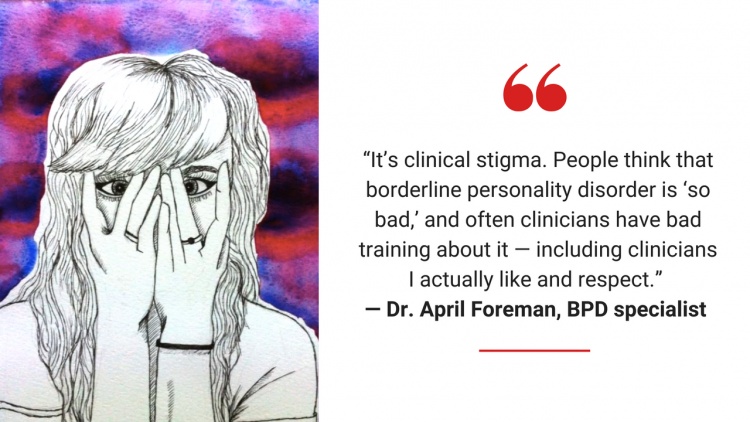
According to Dr. Foreman, often mental health professionals are hesitant to diagnose someone with borderline personality disorder (BPD) because they aren’t taught about BPD in a helpful way.
Clinicians are afraid to do it because one of the things they tell us in graduate school is, ‘Don’t give someone a personality disorder until you know that they have one.’ Now I don’t know why they are so insistent upon that vs. major depressive disorder. I can only surmise that it’s clinical stigma. People think that borderline personality disorder is ‘so bad,’ and often clinicians have bad training about it — including clinicians I actually like and respect.
Foreman said she’s heard clinicians say insensitive and scientifically inaccurate things about BPD — things that make her feel unable to send patients with BPD their way, because the patient wouldn’t be treated fairly. She said some clinicians don’t want to write BPD down on paper in fear of branding their patient with an “untreatable” diagnosis. Or for some clinicians, “borderline” just becomes a synonym for “bad patient.”
Doctors, non-mental health providers, clinicians in mental health probably over-diagnose patients with painful behaviors — patients we feel annoyed by — as having borderline personality disorder. So it’s probably over-diagnosed in our minds but under-diagnosed on paper. I see a lot more people who actually have borderline personality disorder but don’t have it in their medical record.
She said based on BPD prevalence rates research has shown, “10 to 20 percent of the people coming in to a community mental health center should have a borderline personality disorder diagnosis. I guarantee you it is not on 10 to 20 percent of their clinical files — and it should be.”
How often is borderline personality disorder misdiagnosed? How can I get an accurate diagnosis?
Borderline personality disorder (BPD) is often tricky to diagnose because many of the nine “classic” symptoms are common in other mental health disorders as well. For example, someone with depression might experience suicidal ideation or struggle with self-harm, but doesn’t necessarily have BPD. Similarly, another person with bipolar disorder might display some repeating impulsive behaviors, but won’t meet the full criteria for a BPD diagnosis.
Remember, many folks with BPD often do live with other mental illnesses like depression, anxiety, obsessive-compulsive disorder (OCD), eating disorders, etc. — so when a clinician diagnoses a patient with undiagnosed BPD, they are not necessarily “misdiagnosing,” just not giving a complete and accurate diagnosis. Because of factors like clinical stigma, lack of good education about BPD and the fact that BPD can “look” like a lot of other illnesses, it is one of the most misdiagnosed mental illnesses.
Being misdiagnosed can also happen the other way around when someone without BPD is diagnosed with it. Dr. Foreman said this sometimes happens to people who are living in the midst of a toxic environment.
If someone’s currently in an abusive or invalidating environment, you can look pretty “borderline.” Like if you take any person and you throw them in an abusive relationship where you get gaslighted a lot for example, or invalidated a lot, you’ll start to act pretty “borderline” because that’s an adaptive response to a “crazy” environment.
She said the difference between a more typical person placed in an abusive situation and someone who has a persistent struggle with BPD is what happens to both people when they are removed from the abusive situation.
“With borderline personality disorder, what you’re seeing is when we take you out of the environment, what happens is you’ve been changed and those behaviors persist even when you’re in a relatively stable, non-invalidating situation,” she said.
So is it possible to get an accurate diagnosis of BPD if you think you have it?
Dr. Foreman says yes. She highly recommends the Personality Assessment Inventory (PAI), an hour-long test you can get a referral for from your primary care physician or mental health professional.
According to the PAI website, the test assesses psychopathological syndromes and provides information relevant for clinical diagnosis, treatment planning and screening for psychopathology.
Dr. Foreman likes the test because it measures different disorders — even similar disorders — using statistically separate scales for each disorder. For example, the test has a scale that measures bipolar disorder only, a separate scale for BPD, depression, anxiety and so on. When you take the test it will show you if you have BPD, what BPD symptoms you scored “high” on and it will tell you if you have other co-occurring mental disorders.
It’s a really good measure. It can help you clarify what parts of your symptoms are related to your personality disorder… and what things have to do with mood disorders, PTSD, anxiety and substance abuse. It also has scales for suicide risk and they are all separate scales.
Dr. Foreman says the test is a few hundred dollars and insurance will typically cover it. You must get a referral from a doctor to take the test because it’s complex enough that it takes training to score and explain the results.
If you are nervous or don’t know how to ask about it, she recommends approaching it this way:
You can say, “I would really like to have a thorough assessment of my diagnosis, can I get something like a Personality Assessment Inventory?” and “What are my options for getting a full psychological evaluation? I want to really clarify my diagnosis and use it to review my treatment plan.”
As we mentioned above, the test will not only let you know if you have BPD, it will let you know if you have other mental disorders. This is particularly useful because not all people with BPD will have the same exact treatment plan. For example, someone with BPD who also has OCD or generalized anxiety disorder will have different needs than someone with BPD and depression. According to Dr. Foreman, knowing your diagnosis gives you a lot to work with when discussing medication, intervention and skills needed for your individual recovery.
I think I have borderline personality disorder. What now?
Because of the stigma surrounding borderline personality disorder (BPD) — from laypeople and clinicians alike — it might be easy to think that avoiding a diagnosis of BPD is the way to go. But we asked Dr. Foreman if she thought there was a benefit to getting an official diagnosis, and she promptly responded, “You bet.”
“Get the diagnosis. Get it right, and if you are not getting better within a few months, get a change in your treatment plan,” she said.
She explained that if you are not experiencing tangible results from therapeutic intervention, it is vital to be your own recovery advocate. Have a conversation with your therapist and ask tough questions like:
- “What am I doing to get in the way of my recovery?”
- “What are you as a therapist doing to get in the way?”
- “What problems must we solve so that I can get better?”
She said to be prepared for your therapist to suggest things you could be doing better to engage more fully in treatment. Dr. Foreman was clear that if you are a patient with BPD, you can’t “fail” at therapy, but if things aren’t improving, it’s essential to advocate for your needs.
“As long as you’re doing your part, you should be getting better. And getting an accurate diagnosis and a correct treatment plan is a big part of that,” she said.
If you think you have BPD but are ashamed or afraid of having the diagnosis “officially,” you’re not alone. Though there is absolutely nothing shameful about struggling with BPD, it’s OK to have fear about potentially receiving a new diagnosis. If you relate to this, Mighty contributor Kayleigh MacDonald has some words you might need to hear from her piece, “What I Learned When My Diagnosis Changed From Depression to BPD.”
My diagnosis changed. But my world didn’t. A new condition’s name did not strip me of how I felt. I was still valid. How I felt was still valid. It was still OK to not be OK.
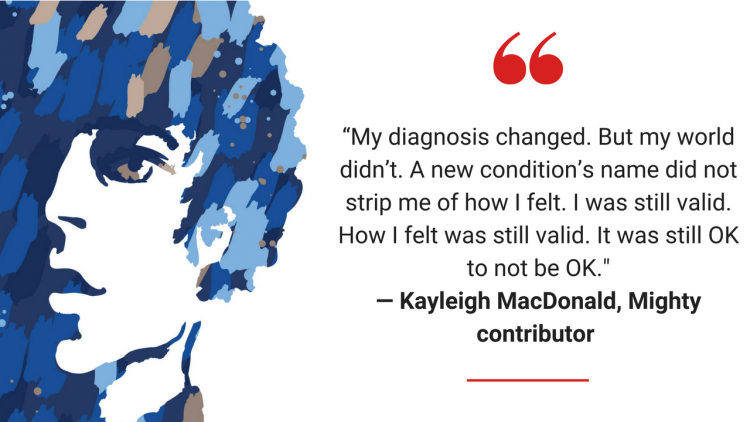
If you live with BPD, we want you to know you are not “untreatable” or “evil” or “too much” or any of the other things people can say about folks with BPD. In fact, many people with BPD have positive qualities we don’t typically talk about like being highly empathetic, creative and self-aware. And though it’s true that living with BPD can often be difficult, it’s not hopeless. Like all mental illnesses, BPD simply requires you to put in the work to get better. Recovery is completely possible, BPD warriors. Keep at it.
Do you have a question about borderline personality disorder that we didn’t address? Let us know in the comments below.
Artwork via Charmaine Selwood and Getty Images

